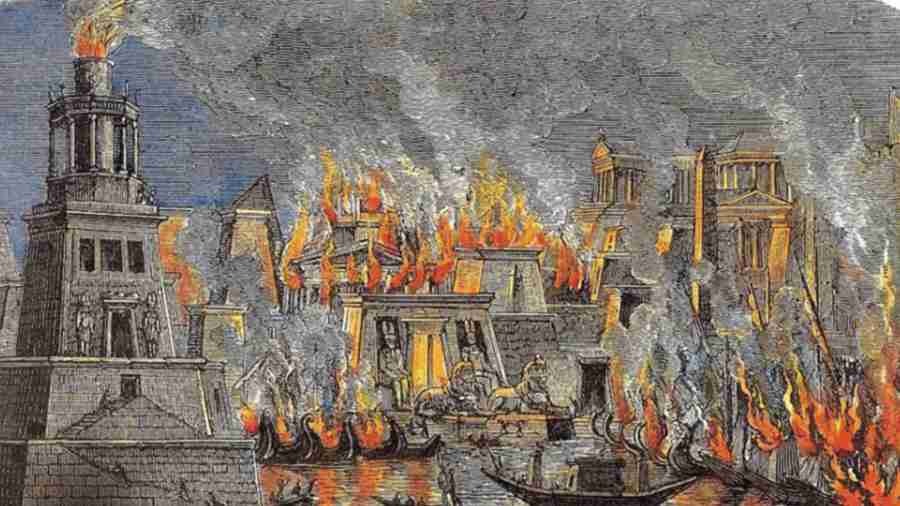Book: Papyrus: The Invention of Books in the Ancient World
Author: Irene Vallejo (Translated by Charlotte Whittle)
Publisher: Hodder & Stoughton
Price: £16.99
If the universe, according to the librarian extraordinaire from Buenos Aires, exists as an infinite library — from where did its first books appear? What triggered the conceptualisation of the book — the most fragile of human inventions, yet one that makes us who we are? And when exactly did the strange human passion for book-collecting begin? In Papyrus, the answers focus on the dream of the Library of Alexandria, where the first impossible attempt to archive all existing books began in the classical world.
Many ancient libraries existed prior to Alexandria, Irene Vallejo explains, but they existed as exclusive private repositories of kings and priestly elites. Exclusivity had its privileges — the last great Assyrian monarch, Ashurbanipal, owned a library of clay tablets dedicated to his “royal contemplation and reading”; the secretive Egyptian priests had Houses of Books for administrative documents and Houses of Life where sacred hieroglyphics preserved the traditions of a plethora of gods and thirty successive dynasties of pharaohs on papyrus and stone. But the absence of cross-cultural dissemination also ensured that when their empires fell, and desert winds swept over the half-buried cities — “what was left of their writing, once discovered, was indecipherable.”
The uniqueness of the Musaeum of Alexandria (also called the Birdcage of the Muses) lay in its extensive book-catalogues and translation projects initiating dialogue across cultures: it provided free access and residency to scholars from anywhere across the Mediterranean. Believed to be modelled after the personal library of Aristotle, whom the Alexandrian scholars deferentially referred to as “the Reader”, the Musaeum was patronised by the Ptolemies (a dynasty of fourteen Macedonian kings which ruled Egypt for three centuries after the death of Alexander and ended with the suicide of Cleopatra in 30 BCE). A second library called the Serapeum — built by Ptolemy III in honour of Serapis, the composite patron deity of Alexandria — preserved copies of authoritative editions of scrolls held at the Musaeum and was open to anyone willing to read: “the first public library truly open to rich and poor, elites and outcasts, free men and slaves.”
Vallejo shuns chronology to take her reader through a fascinating guided tour of the rise and the fall of these two ancient libraries and the variegated reading cultures of the Graeco-Roman world, while interweaving her narrative with personal memories of reading from what Alberto Manguel calls the “library of the mind”. She also shares enthralling anecdotes about the firstknown literary fans in history, the defiant inscriptions of the last of the Egyptian scribes, and, preserved for posterity by the volcanic eruptions of Mount Vesuvius, the story of the mysterious Villa of the Papyri at Herculaneum.
But what caused the demise of the Library? Rather than put the blame squarely on Julius Caesar’s incendiary fires, Vallejo sees a slow demise set in motion by political insensitivity, gradual withdrawal of imperial funds, and increasing religious fanaticism. By the time of the decline of the later Roman Empire, according to the last of the imperial historians, Ammianus Marcellinus, the Musaeum housed 700,000 scrolls. At the beginning of the third century CE — as a retribution against Aristotle for the supposed poisoning of Alexander, dead six centuries earlier — the Roman emperor, Caracalla, threatened to set fire to the Musaeum where the ghost of the Reader was believed to have taken residence. Caracalla did away with the privileges of the scholars and his troops later sacked Alexandria, killing thousands. Successive emperors followed him in withholding financial support, while Alexandria was repetitively plundered and pillaged. By the end of the third century — going by the testimony of Marcellinus — the walled precinct of the Musaeum was wiped off the map. Almost a century later, in the year 391 CE, a fanatical mob of Christians led by the bishop, Theophilus, razed the Serapeum to the ground. The dissolution of the Library was complete in 415 CE when Hypatia, the last of the Alexandrian philosophers, was dragged through the streets of the city on charges of witchery and brutally lynched by religious zealots. Her father, the mathematician, Theon, is remembered as the last resident of Musaeum.
Writing in a new biblioclastic century that began with the looting of museums and libraries of Iraq, Vallejo pertinently reminds us of an observation by El Roto: “Civilizations grow old; barbarity is reborn.” In the magical, melancholy city of books conjured by Papyrus, however, the Alexandrian poet, Constantine Cavafy, and his reader, Joseph Brodsky, rediscover lost twilight worlds, as does Palladas, the last of the Hellenistic Greek poets who was a first-hand witness to the destruction of the Serapeum and the burning of most volumina, the scrolls of classical antiquity. And black butterflies — ashes of books that fell from the sky on the people of Sarajevo after the bombing of their National Library in 1992 — keep flying across all imagined futures of the book.











